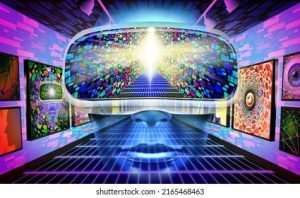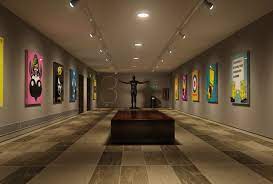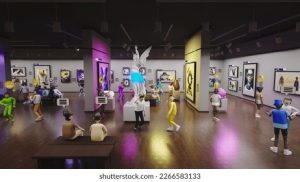The year is 2025, and many human experiences, which used to be conducted in person, have been converted to digital experiences. These digitized experiences may take the form of teleconferencing, virtual reality (VR) augmented reality (AR), virtual tours or other interactive web-based experiences. This practice has had many praises and criticisms. Criticisms often relate to the idea that the digital experience is less authentic, isolating and limiting. Praises include the fact that digitization decreases traffic, reduces spread of diseases and is convenient. In the case of museum experience, offering digitized options would help the museum’s sustainability, provide many people who normally wouldn’t have the means to visit a chance to experience their collections, and increase their revenue in many ways.


Museums have been working with VR applications for a long time but have only been visibly mainstream with this since the 2020s. As early as 2016, the Smithsonian American Art Museum (SAAM) undertook a series of experiments in producing Virtual Reality (VR) applications, to gain hands-on experience with the technologies involved, and to increase the museum staff’s firsthand knowledge of the medium (Snyder, 2018). Over the years, SAAM observed that in the early days, issues that hindered virtual museum experience included uncomfortable or heavy VR headsets and reliance on computers. In recent years, VR headsets have become lightweight and do not need to be tethered to computers. VR technology is improving rapidly and will likely become more prevalent in more museums as time moves on.


In more recent years, museums have mostly adopted AR and VR technology into their visitors’ experience. For example, the Metropolitan Museum of Art in New York made the decision to digitalize over 380,000 images from its collection to make its collection accessible to more users. In 2019, the Prado Museum in Madrid introduced its first innovative 360-degree immersive VR experience, which allows users to get a closer look at the artworks and artefacts than they would in person (Charr. 2020).
Overall, the advantages of AR and VR are starting to outweigh the disadvantages for museums and visitors. While the virtual experience cannot replace in-person experiences, it can make experiences accessible for more users and increase sustainability for the museum.
References:
Snyder, S. (2018, January 15). Possibilities and constraints for virtual visits: Experimental approaches to VR at the Smithsonian American Art Museum. MW18 Museums and the Web 2018. https://mw18.mwconf.org/paper/possibilities-and-constraints-for-virtual-visits-experimental-approaches-to-vr-at-the-smithsonian-american-art-museum/
Richardson, J. (2025, January 3). How technology is bringing museums back to life. MuseumNext. https://www.museumnext.com/article/how-technology-is-bringing-museums-back-to-life/
@xoya These are good examples of what is possible in the museums. Having access to a digital representation of an object I may never get to actually see in person is very cool. And I usually get dizzy with too much AR/VR type stuff, but I’m hoping eventually there will be useful technology to prevent that so I can, for example, to or someplace on the other side of the world via VR.
Yes, I do remember hearing that VR and AR have been working on issues that many users experience with dizziness. Improving this would be really important for making the technology more accessible to more people and also to make it more comfortable for everyone.